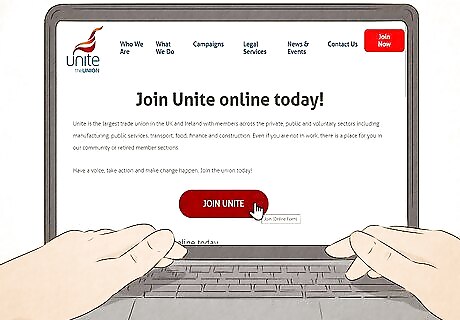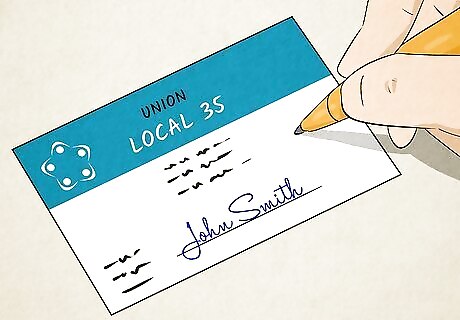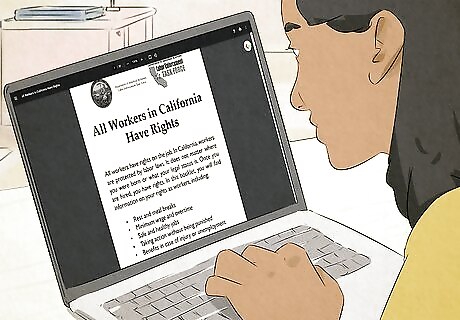
views
X
Trustworthy Source
National Labor Relations Board
Independent U.S. government agency responsible for enforcing U.S. labor law in relation to collective bargaining and unfair labor practices.
Go to source
Still, there is a lot that can go into organizing, so we’ll break it down for you. Read on to learn everything you need to know about creating a union.
- Your employer cannot penalize you for trying to unionize your workplace so long as you do it outside of work hours and off of company property.
- Join a preexisting union, or start a brand-new union from scratch.
- Hold an informal vote to unionize. If 30% or more agree, contact the NLRB to formalize a vote. Then, if 50% + 1 agree, your union is legal!
- There are no minimum sizes for a union. If a company has 2 employees, those 2 employees can form a union.
Benefits of Unionization

Unions allow your colleagues to work together to earn fairer work conditions. A union’s biggest strength is collective bargaining. Whenever a worker is wronged, management makes a decision that pertains to something in your contract, or it’s time to negotiate over work conditions, everyone in the union stands as one to bargain together. This way, your employer doesn’t hold all the power. Unionized employees tend to be paid more, have better benefits, and more due process at work than their non-unionized counterparts. Workers who unionize tend to have better insurance, more vacation time, better retirement security, fairer wages for women and minorities, and more paid leave for expecting parents and injured workers. If an employer refuses to treat their employees fairly, a union can go on strike and refuse to work.
How to Unionize in the Workplace

Approach the coworkers who will be most discrete and sympathetic. Make a list of your coworkers and rank them from “most likely to keep a lid on this and be on board with forming a union” to least likely. Talk to the folks at the top of that list privately to gauge their level of interest. If your boss hears about your plans before you've organized, they might try to stop you (by, for instance, finding a reason to fire you that's unrelated to unionization), so keeping things under wraps at the beginning is key. Unionizing while you’re clocked in at work is almost certainly going to be against your company’s policy, and it’s actually illegal in some states. To avoid getting in trouble, reach out to your coworkers when nobody is actually on the job. If you start by approaching coworkers who you know aren’t fond of unions (or who tend to suck up to management), they may run off and tell your boss instead of joining your efforts. Whenever possible, actually talk. Don’t text or email. That way, if anyone wants to turn you in, they won’t have evidence you’re trying to form a union.

Avoid including anyone with hiring or firing power. Don’t consult anyone who has the ability to hire more employees, or fire other employees. Include only the coworkers who are under the same direct management as you. The roles can be different, but so long as you all work for the same upper management and none of you can hire or fire one another, anyone can join your union. For example, if a school teacher wants to unionize, they can choose to include other teachers, the janitors, and security staff. However, they shouldn’t ask the department heads, HR, or assistant principal to join.

Meet as a group to discuss the next steps. If, after quietly talking to your coworkers, you find that enough of them are interested, hold a private meeting with your coworkers outside of work. At this meeting, discuss the particular workplace issues that you feel need addressing. Keep a record of the issues discussed at this meeting for future reference. Once everybody is on board with the idea of forming a union, you can begin the official process. So long as 30% of you are interested in forming a union, you can host a legally-protected vote. If over 50% of you are interested, your union will be recognized once that vote takes place. This is a good time to talk about who wants to be on the union’s central committee.

Join a relevant preexisting union if one exists. You do not have to start a union from scratch if an organization already exists. For example, if you work at a school, you could reach out to the National Union of Teachers and tell them your school wants to join. If you work for a construction company, you could contact the Trades Union Congress. It’s easier to join a larger union than to start one from scratch, so see if a relevant union exists. A lot of union organizations are state-based, so if you look online and can’t find a union to join, try searching for your specific state. Just call the union’s main phone number and explain the situation. Organizers will know what you need to do and they’ll help you along the way. You’ll also have immediate access to the preexisting union’s legal counsel and organizational structure, which makes the early work a breeze.

Contact a union organizer if you want to form a brand-new union. Starting a union by yourself can be a daunting task. That’s why it helps to have an experienced union organizer to do it for you. Reach out to the AFL-CIO (The American Federation of Labor and Congress of Industrial Organizations) and ask for free help from an organizer. They’ll send you an organizing vet to help organize a legal vote, set up a functional union structure, and answer your questions.

Hold a card check election to determine who’s joining the union. A card check is a simple election process where employees meet and either sign up for a union card, or do not decide to join. If you have enough cards at the end of the count (usually 50% + 1), you may have successfully formed a union depending on where you live. If not, you’ll need to hold an election with the corporate management. The states where card checks aren’t automatically acknowledged are mostly the same list as the “right to work” list. Even if the card check doesn’t officially make you a union, it’s still important to perform this step. In most states, the cards themselves provide certain legal protections under the NLRB (National Labor Relations Board).

Hold the formal election to finalize your union. If the company doesn’t recognize your union immediately based on the card alone, contact the NLRB. The NLRB will help you organize a legally binding and formal vote. If the election is held and you get over 50% of the vote, your employer must recognize and then bargain with the union. The NLRB will take several weeks to schedule the election and determine voter eligibility. During this time, you can continue the union campaign to encourage more members to sign cards.

Negotiate a contract with your employer. Once your union is formed, the first thing you need to do is negotiate a union contract with your employer. This document covers wages, dispute resolution, and other employment-related matters. This is the cornerstone of every union’s ability to mobilize and enforce demands, so take your time hashing this one out. This is where having a professional union organizer is really helpful. They’ll know what a fair offer from management looks like given the strength of your union. There are typically legal restrictions on what can and cannot be included in a union contract, so reach out to a local labor attorney if you need help.
How many people do you need to unionize?

You only need 2 people to form a union. Any workforce can unionize so long as there is more than 1 employee. There are no size restrictions, so don’t let anyone talk you (or your coworkers) out of unionizing on the grounds that there are too few or too many of you.

A formal union needs 30% of employees to be on board for a vote. As soon as you reach or surpass 30% of your workforce who wants to unionize, contact the NLRB to organize a vote. The 30% figure is the threshold where your organization efforts become formally and legally protected.

You need over 50% of the employees to vote in favor of unionization. So long as 50% + 1 of workers elect to form a union, the union is legitimate. Your employer is now legally required to negotiate with your organization. Remember, if you’re in a right-to-work state like Florida or Indiana, your union cannot require your coworkers to join the union if they don’t want to—even if your union vote was over 50%.
Tips for Unionizing Safely

Look up your state laws before you do any organizing. In the U.S., many federal laws outline what unions are allowed to do, but there’s a lot of minutiae that can change things on the state level. Refer to your state laws regarding the right to form a union, to express views on unions, and to talk to coworkers about an interest in forming a union. You can consult a local labor attorney to find out what your rights are if you can’t find information online. The key consideration is whether your state is “right-to-work” or not. Right-to-work states have laws that make it difficult for unions to negotiate or form in the first place. Do not worry if your job is “at will.” You’re legally protected here—your job can’t fire you for trying to form a union.



















Comments
0 comment